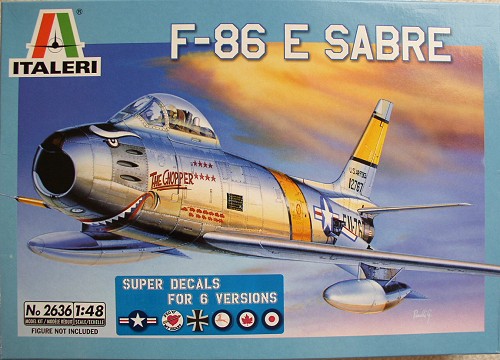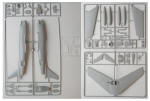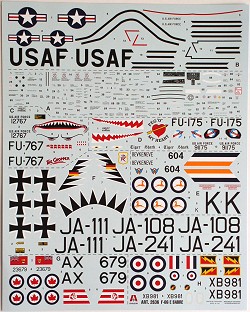
| KIT: | Italeri 1/48 F-86E Sabre * |
| KIT #: | 2636 |
| PRICE: | $22.00 MSRP |
| DECALS: | Six options |
| REVIEWER: | Tony Hodun |
| NOTES: | Reboxed ESCI kit |

| HISTORY |
The history of the North American F-86 Sabre is well documented, so I won’t repeat much of it here. The Sabre day fighter version’s biggest claim to fame is its success versus the MiG-15 in the hands of USAF pilots of the 4th FIW and 51st FIW during the Korean War, where it also served late in the war as a fighter bomber (and MiG-15 beater) with the 8th FBW (including 2 Squadron SAAF), and the 18th FBW. In addition to North American Aviation production, similar Sabre day fighter versions were built in sizeable numbers by Canadair of Candad and by Mitsubishi Heavy Industries of Japan (Australian built day Sabres were Avon engine powered and had a deeper, larger fuselage and other differences). In total, at least 35 nations around the globe operated one or more versions of day fighter Sabres during its operational history.
The F-86A/E/F Sabres and similar Canadair Sabres were built with one of four wing configurations, each improved performance in one or more areas, and typically earlier airframes were retrofitted with later improved wings. This is important to know when one tries to build an accurate Sabre or tries to assess which wing is included in a particular kit. Photo references are essential if you’re trying to accurately model a particular airframe at a particular time in its life.
The day Sabre wing types are as follows.
1) Original slatted wing – original equipment on F-86As, F-86Es, early F-86Fs, and Canadair Sabre Mk 2s and early Mk. 4s. The Cutting Edge conversion is currently the only accurate way to build this wing in 1/48 scale. The outer edge of the ailerons form part of the wingtip.
2) ‘6-3’ fixed-edge wing – the slats were replaced with a fixed leading edge, the wing leading edge was extended in chord by 6 inches at the wing root and 3 inches at the tip, increasing the sweepback angle and increasing wing area by roughly 5%, and a fence was added outboard of mid-span to reduce spanwise flow. The original ‘6-3’ wing was original equipment on later US F-86Fs, late Canadair Sabre Mk 4s, Sabre Mk. 5s, and early Sabre Mk.6s. This wing was retrofitted to many remaining early-winged Sabres. In 1/48 scale this wing is found in the Monogram, Academy, and Hasewaga F-86F-30 kits.
3) ‘6-3’ slatted wing with 12 inch extended tips – slats were restored (same span length as original), fence was removed, wingtips were extended outboard of slats and ailerons. Original equipment on F-86F-40s, retrofitted to many earlier F-86Fs. Found in the 1/48 Hasegawa F-86F-40 kits.
4) ‘6-3’ slatted wing with original length tips – slats restored, fence removed. Original equipment on later Canadair Sabre Mk. 6s, retrofitted to most early Sabre Mk. 6s and some Sabre Mk. 5s. The Hasegawa Sabre Mk. 6 includes resin wingtips to convert the kit’s extended ‘6-3’ wing to this version. Apparently later Canadair Sabres equipped with higher thrust Orenda engines didn’t need the tip extensions. They ruled the roost in NATO during their heyday, and could outfly the USAF J-47 powered F-86s. I’ve not found the specific explanation yet, but I am sure it was a conscious design decision.
| THE KIT |
 I’ve always like
the F-86 Sabre, specifically the day fighter versions. Since I was born
shortly after the close of Korean War hostilities in July 1953, my earliest
picture of what a jet fighter should look like was shaped by that famous
swept wing open-mouthed design. To me, the Sabre and Fury have always
looked fast even while they are sitting still. So I had to consider
checking out this baby when it showed up at my local hobby shop.
I’ve always like
the F-86 Sabre, specifically the day fighter versions. Since I was born
shortly after the close of Korean War hostilities in July 1953, my earliest
picture of what a jet fighter should look like was shaped by that famous
swept wing open-mouthed design. To me, the Sabre and Fury have always
looked fast even while they are sitting still. So I had to consider
checking out this baby when it showed up at my local hobby shop.
For years consensus has been that the best Sabre kits in 1/48 were the Monogram and the ESCI products; some favored one over the other. The raised panel line Monogram kit was assessed to have the most accurate shape, while the ESCI kit had engraved panel lines, but also some shape problems. Both have inserts or open panels to contend with. In more recent years we have been blessed with very well engineered and more-highly detailed 1/48 scale kits of the F-86F from both Academy and Hasegawa. As a result, it seemed highly unlikely to me that this kit would be based on new tooling.
Upon opening the Italeri box, no surprise awaited me, I was greeted with what is clearly a reissue of the old ESCI 1/48 F-86E. The 73 parts are done in Italeri’s typical light grey plastic on 3 trees, and appear well produced, with minimal flash present. There are a few small sink marks on the underside of the fuselage halves adjacent to locator pins that could use some filler. The main fuselage parts tree is carefully cut into two pieces to fit the standard Italeri box size, and typically for an Italeri kit, the main parts trees do not come in a bag, so there is the possibility of parts scratching one another. Thankfully, the small clear tree of 6 additional parts is in a separate sealed bag. The kit has a few options, they include the later 200 gallon drop tanks with two styles of fins (with or without end plates), speed brakes and canopy that can be assembled open or closed, and early AIM-9 Sidewinders with inboard rocket rails appropriate to the few day Sabres that were equipped with them. The instruction sheet is incorrect in that it calls for AIM-9s to be installed on RAF or RCAF versions; neither were so equipped. None of my numerous Sabre references provides a definitive picture of which day Sabre operators had some or all of their aircraft modified for AIM-9s, but a partial picture follows. The major user seems to have been the new Luftwaffe, who had all remaining Sabres made AIM-9 capable in 1962; South Korea, Nationalist China, and Japan all had some number of Sabres made missile capable, and there were probably others with other air forces. The real gem in this kit is a huge box-sized sheet of decals produced by Cartograf of Italy that do 6 different Sabres; more on this later.
The wings in this kit most closely resemble the later 6-3 slatted wing with extended wingtips. When I dry fitted them against the 6-3 wings and 6-3 extended slatted wings from the Hasegawa kits, I concluded that the kits’ wings basically have the 6-3 chord increase and are closest in span to the extended 6-3 wing; the ailerons also match that wing type. They are not an exact match to either the Hasegawa parts or to published drawings however. Sabre expert Larry Davis told me he drew the same conclusion years ago. Since the kit wings are a tad short in span, you could use them to represent the Sabre Mk. 6 wing, or you can ignore the increased chord and aileron ending before the wingtip and build an early slatted wing Sabre. The purist will need to use the Cutting Edge conversion set to build an accurate early slatted wing day Sabre, and would be better off getting the newer Hasegawa kits for the other slatted wing versions.
I took the time to dry fit the major parts of the kit for this preview, and found that the fuselage halves and main wing panels fit reasonably well. If you remove the lower wing from the trees with proper care the only areas that may need filler are the leading edge wing roots, and possibly the join lines between lower wing and fuselage. ESCI designed this kit as part of a family of F-86E/F, FJ-2/3 Fury, and Canadair Sabre, so the kit has some inserts to contend with that the other 1/48 scale day Sabres do not. The nose gun panels are separate pieces, since the Sabre has three .50 cal machine guns per side, and the Fury has two 20 mm cannon per side. The nose to fuselage joint may take some sanding and filling, but if done with care the MG panels look like they will fit well. The upper part of the nose is narrow, so it has a pinched look compared to drawings; this is the kit’s most noticeable shape problem. There also is a sizeable triangular insert for the aft fuselage underside to fill in where a recessed tail hook would be found on the Fury, and you will need to glue this correctly on the supports inside the fuselage, and have to do some filling and sanding to close the small gaps and fair in the insert. The instructions call for 20 grams (about 2/3 oz.) of nose weight; don’t forget it, the kit will likely be a tail sitter without it! The weight will have to be squeezed behind the nose piece, above the nose wheel well, and ahead of the cockpit, which looks tricky. If you use the drop tanks, some weight could be added inside the nose area of each tank to help keep the nose down. The bottom line is that the kit will need some work with fitting, filling, and sanding; it won’t be as easy to build as the newer kits on the market.
 THE MARKINGS: The
high point of this kit just might be the huge decal sheet provided, almost
as large as the kit box! The box art says 6 versions are provided;
actually one can do one of 8 different aircraft operated by 5 different
nations, as numbers are provided for three different Sabres of the new
Luftwaffe’s JG71. A full set of stencils and instrument panels for one
aircraft is provided. The individual aircraft options provided are below.
Italeri’s paint scheme captions leave a lot to be desired, so I have added
info or made corrections based on my research. The Canadair built Sabres
seem to be based on profiles found in the Warpaint book.
THE MARKINGS: The
high point of this kit just might be the huge decal sheet provided, almost
as large as the kit box! The box art says 6 versions are provided;
actually one can do one of 8 different aircraft operated by 5 different
nations, as numbers are provided for three different Sabres of the new
Luftwaffe’s JG71. A full set of stencils and instrument panels for one
aircraft is provided. The individual aircraft options provided are below.
Italeri’s paint scheme captions leave a lot to be desired, so I have added
info or made corrections based on my research. The Canadair built Sabres
seem to be based on profiles found in the Warpaint book.
1) F-86E-10 FU-767 / 51-2767 “The Chopper”, USAF 336 FIS/4 FIW, flown by Major Felix Asla, Jr., K-14, Korea 1952, includes a smiling shark mouth and kill/mission markings, in NMF with black edged yellow theatre ID bands. The modeler must paint the yellow of the theatre ID bands on all three Korean War schemes.
2) F-86A-5 FU-175 / 49-1175 “Peg “O” My Heart/Tiger Shark”, USAF 336 FIS/4 FIW, flown by an unknown pilot, Kimpo, Korea 1952, includes a shark mouth and kill/mission markings, also in NMF with black edged yellow theatre ID bands. (Editor's Note: If this is indeed an A model F-86, then this aircraft cannot be built using this kit as the windscreen and horizontal stabs are different on an A model)
3) F-86F-30 604/Black K “BEVKENEVE”, of SAAF No. 2 Squadron, Korea 1952, in NMF with black edged yellow ID bands.
4) Sabre Mk. 4 XB891, Grey Q, of RAF No. 4 Squadron, in European camo colors, Jever, 1956.
5) Sabre Mk. 6 23679, AX * 679, of RCAF 421 “Red Indian” Squadron, RCAF 2 Wing, Grostenquin, France, 1957, in European camo colors. Note that Grostenquin is a location, not the Squadron nickname!
6) Sabre Mk. 6 JA-111, JG71 “Richtofen” of the new Luftwaffe (initially commanded by Major Eric Hartmann, top scoring fighter pilot of all time), 711 Staffel, Oldenburg, 1957, in NMF. JG71 applied a variation of Hartmann’s famous Black Tulip markings to the nose and vertical tail of its aircraft. 711 Staffel’s Sabres carried red trim and were initially numbered in the JA-1xx series. These colorful markings were retained when the Luftwaffe painted their Sabres in camouflage colors. I believe camo was added prior to 1962, so Sidewinders may not be appropriate with the NMF Luftwaffe schemes. The modeler must paint the staffel trim colors on all three JG71 schemes.
7) Sabre Mk. 6 JA-128, JG71 of the new Luftwaffe, 711 Staffel, in NMF with markings as above.
8) Sabre Mk. 6 JA-241, JG71 of the new Luftwaffe, 712 Staffel, in NMF with markings as above. Missing from the instructions is the note that 712 Staffel used yellow for identically shaped trim colors adjacent to the Black Tulip markings, not the red shown for the JA-111 markings.
The decals are produced by Cartograf, and are thin and well printed, so they are a known quantity and should be easy to use. Some of the markings may need to be tweaked to fit other manufacturers’ kits, most will work fine on other manufacturer’s Sabres.
| CONCLUSIONS |
My initial reaction to the price of this kit was that it seemed somewhat high for a reissue of the old ESCI Sabre. The box top copy referring to “Super Decals For 6 Versions” pushed me off the fence into purchasing the kit (sometimes you just have to know what’s in that box, know what I mean?). When I examined the huge sheet of excellent decals included, I realized what I really had purchased was an average kit and a large, quality aftermarket decal set. In that light, the kit looks like a good enough value, especially if you are enough of a Sabre fan to use the leftover decals on one (or more!) of the other unbuilt Sabre kits in your stash! Scott tells me he’s seen this kit built up well, it depends on the modeler’s skill. Just don’t expect the kit to build up as easily as the newer Academy and Hasegawa Sabres, and you won’t be disappointed. It’ll look enough like a Sabre when you’re done!
Preview kit courtesy of my wallet!
Personal aside here: I really appreciate the fact that Italeri is finally producing some of these out-of-production ESCI kits, and while this one has been superseded by more accurate kits, a number of the recent issues (e.g. MB.326, S-3A/B) represent the only version available in this scale, and are decent builders. If you feel the same way, keep buying them, and it doesn’t hurt to let Italeri know via their website, like I have.
| REFERENCES |
Wings Of Fame Volume 10, pp. 34-99, “North American F-86 Sabre”, by Larry Davis, 1988, Aerospace Publishing Ltd
F-86 Sabre In Action No.33, Larry Davis, 1978, Squadron Signal Publications
F-86 Sabre In Action No.126, Larry Davis, 1992, Squadron Signal Publications
Warbird History: F-86 Sabre, Robert F. Dorr, 1993, Motorbooks International
Warpaint Series No. 40: Canadair and Commonwealth Sabres, Steve Hazell, ca 2004, Warpaint Books, Ltd
Famous Aircraft of the World No. 20 (new series), North American F-86 Sabre, 1990, Bunrindo Co.
Wings Of Fame Volume 1, pp. 142-165, “Phoenix Twice Risen: Jagdgeschwader Richtofen”, by John Weal, 1986, Aerospace Publishing Ltd
My thanks go out to Larry Davis and Warren Thompson for their research assistance!
If you would like your product reviewed fairly and quickly by a site that has nearly 300,000 visitors a month, please contact me or see other details in the Note to Contributors.